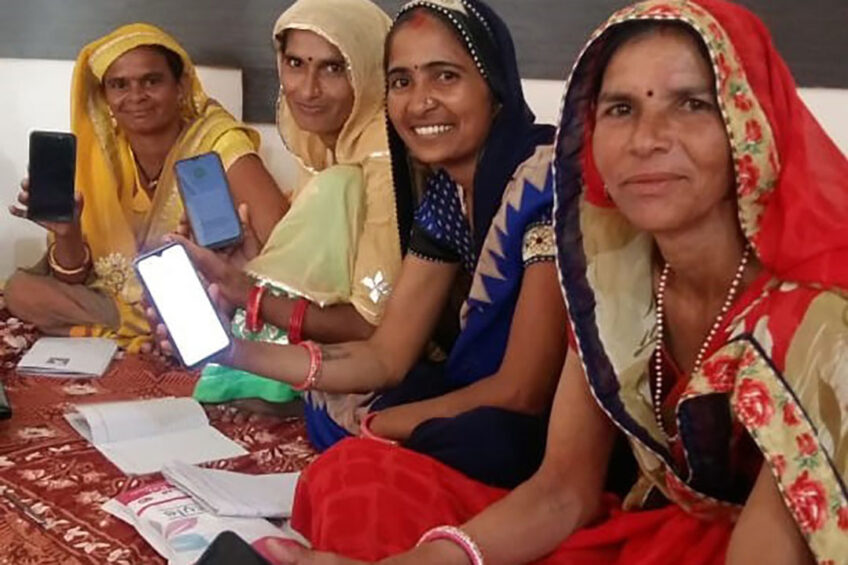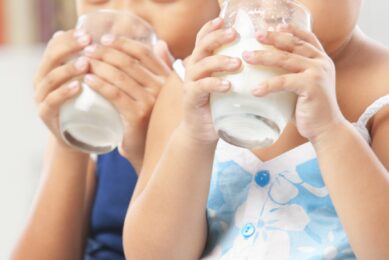From tradition to technology – empowering India’s dairy farmers

India is the top milk producer globally and it is also a country where traditional and modern farming practices are very much intertwined. With milk demand in India on the rise there are still many challenges that dairy farmers are facing. Helping to tackle some of these challenges head on is the award-winning Indian agtech company MoooFarm.
This start-up has made great strides in uplifting rural farmers in India. From driving on-farm efficiency, upskilling small holder farmers at village level to increasing farmer income, and they are just getting started.

Bridging the gap for farmers
Agtech company, MoooFarm, is playing a significant role in meeting some of these challenges, with an impressive 15,000 plus dairy farmers already trained. The company is bridging the technology gap to help usher marginalised dairy farmers into the 21st century. MoooFarm founder Param Singh and co-founder Aashna Singh have a vision to make dairy farming in India more efficient in a sustainable way. After spending 17 years in Australia, Param sought to set up a large-scale business project in India, his main objective was centred around bringing education and to develop skills in India.
Founders Param Singh, founder and CEO is a recipient of the prestigious scholarship from Stanford University in ‘Social Entrepreneurship’. His first start-up won six state and national awards and was acquired by an Australian public listed company in 2014. He has won many awards including Australia-India Young Entrepreneur of the Year in 2013 and Australians making a difference in India in 2018 by the Department of Foreign Affairs and Trade. Param is a recipient of “Nanak Nam Leva Prominent Personalities” State award from Punjab Government in India
Param Singh, founder and CEO is a recipient of the prestigious scholarship from Stanford University in ‘Social Entrepreneurship’. His first start-up won six state and national awards and was acquired by an Australian public listed company in 2014. He has won many awards including Australia-India Young Entrepreneur of the Year in 2013 and Australians making a difference in India in 2018 by the Department of Foreign Affairs and Trade. Param is a recipient of “Nanak Nam Leva Prominent Personalities” State award from Punjab Government in India
 Aashna Singh, co-founder and COO, pursued her post-graduation with Double Distinction from the London School of Economics and University of Sydney Business School. Under her leadership, MoooFarm has won many prestigious awards including the World Bank’s Agri Insure-Tech 2019 challenge for ‘Facial recognition’ of cattle, Microsoft’s AI for Earth grant for ‘Mastitis Detection using ML’ in 2019 and ‘Most Innovative Idea of the Year’ award at the Punjab TIE Conference 2018. In September 2019, MoooFarm won India’s Animal Husbandry Start-up Grand Challenge.
Aashna Singh, co-founder and COO, pursued her post-graduation with Double Distinction from the London School of Economics and University of Sydney Business School. Under her leadership, MoooFarm has won many prestigious awards including the World Bank’s Agri Insure-Tech 2019 challenge for ‘Facial recognition’ of cattle, Microsoft’s AI for Earth grant for ‘Mastitis Detection using ML’ in 2019 and ‘Most Innovative Idea of the Year’ award at the Punjab TIE Conference 2018. In September 2019, MoooFarm won India’s Animal Husbandry Start-up Grand Challenge.The challenges that dairy farmers in India are dealing with vary from low market price, low extension services to low milk production.
“We had the vision of wanting to impact many lives in developing countries, I met Aashna and we explored ideas. There was a United Nations Programme (UNDP) on entrepreneurship and rural women in Haryana, India, and we agreed to be a part of this programme, this is where it all started.” With 75 million dairy farms in India the 2 founders saw an opportunity to bring the much needed skills and knowledge to farmers. MoooFarm places emphasis on aspects like alleviating poverty and ensuring gender equality in dairy farming. The company MoooFarm initially started with Project Mooo, which was launched in 2018, working with about 5,000 farmers. This pilot project was essentially to observe what was really needed in the sector.

Increase milk yield, increase income
The challenges that dairy farmers in India are dealing with vary from low market price, low extension services to low milk production. In terms of low milk production – animal health, nutrition and breeding issues are cited as the main causes. Param says, “When we started out it was clear that in India low milk production was a major issue we needed to look at and try to solve.” Milk production per cow is quite low and below the European par for example. As in the Netherlands for instance on average production is 30 l – 40 l per cow/day, in India it’s on average about 4 l per cow/ day.” It is clear that the difference is significant.
If you make women the champions of digital literacy or information or the app you see more data coming in (from farms) and more adoption of solutions
With their goals in sight and a focus on low productivity, the MoooFarm app was launched (Android platform-GooglePlay store), a dairy farm management application, giving farmers access to relevant dairy farming, they can calculate costs and revenue, map the breeding life cycle of cattle, access real time solutions, view learning options to critical problems, and it allows farm data to be kept in one place. Farmers can connect with suppliers (feed and fodder), on demand virtually connect with service providers (veterinarians), and are able to contact a call centre 24/7 for assistance, hence farm management is taken to the next level and tackling low milk yield with proper and quantifiable solutions is very much within reach. Solving one problem like milk production per cow means that other aspects are considered too – like feeding strategies that work better which leads to higher milk output and which relay to higher farmer income and sustainable production. “By tackling low milk production and improving on the aspects that come with it leads to lower greenhouse gases.” The start-up aims to increase the income of 1 million farmers in India by 2022 – with every 3rd being a woman farmer, as gender equality is at the top of this start-up’s agenda.
We realised that women were not present where the information was being passed on.
Technology in rural India
MoooFarm relies on a network of Village Level Entrepreneurs (VLE) who visit the farmer households and offer ICT training to farmers and ensure successful implementation and usage of the mobile app. “We started to look at breed management and health management technology and how we could solve current farm challenges with technology,” says Aashna. In India there is a lack of a national database or record keeping of cattle. Farmers are not used to recording health checks for example, only the most progressive of farmers, about 5% would keep a basic record “but it’s certainly not a practice the small farmers would follow,” says Aashna, adding that “90% – 95% of farmers in India are smaller farmers.”
New additions to scale up technologyTo drive the future vision and scale up technology, MoooFarm recently appointed two new co-founders – Jitesh Arora as the chief technology officer and Abhijeet Mittal as chief product officer. Both are graduates from one of the Indian Institute of Technology (IIT) Roorkee and are experts in Artificial Intelligence specifically Machine Vision. They together founded a deep tech start-up in dairy sector, Erth.ai, to improve milk quality and ensure milk traceability. |
“With the app farmers have access to a digitised breeding cycle whereby they receive alerts at a particular time, depending on the part of the cycle, they can for instance view a 10 minute video to solve a particular problem – it’s just in time learning,” says Param. Alerts via the app include information on the dry period, heat detection and insemination timing. The e-learning platform was launched to assist in best practices on-farm and show farmers exactly how to carry out best practices. The start-up also keeps a record of all the important data that can be used. “We believe we are one of very few companies globally that started recording farm data and in exchange farmers are rewarded with ‘MoooPoints’ through digital wallet which is an incentive for farmers and they can redeem points for exchange of discount and/or internet data. Aashna believes that 70% of farmer problems in India can actually be solved ‘virtually’ by spending just 20%-30% of the costs that farmers would have spent on a physical visit. “We want to ensure that 75 million dairy farms get the advice from a qualified veterinarian and you can’t possibly imagine that without the use of technology. We also have a toll-free number and virtual on demand access to veterinarians – so farmers can connect via phone call, video call, text message and/or sending a picture. In the current Covid-19 situation and lockdown in India, this virtual service is proving a boon and MoooFarm have provided over 20000 minutes of advisory services to farmers.

2 sides: Old traditions vs new skills
“Breeding, health, nutrition, farm and quality management – we tackle each of these topics, and have identified critical best practices that the farmers should adopt at the first phase level,” says Aashna. India’s dairy farming is steeped in tradition. “That is where the VLE’s and veterinarians can help because we realised that dairy farming practices in India specifically has been passed on from generation to generation, there’s never been formal skilling or training as such.”

With the vets and VLE’s farmers can pass on the much needed farming skills as well as digital skills. Passed on customs does not always render the best outcome and can result inefficiency from a scientific or factual point of view. Aashna says, “For example – giving water to a cattle, I found that some farmers would give perhaps 2 or 3 times a day because this is how they have always done it and were taught, which isn’t enough for cows and we would advise best practices and that the cows need access to water 24/7. Also in terms hygiene and safe water for the animals, we help see that this is a critical problem. We’ve had cases where the water trough is filled with fungi and insects and not a lot of attention was given to cleanliness on-farm. This of course in turn leads to costly mastitis occurring and affects production.” Other examples of what they advise on in terms of farm management and techniques include: feed and what goes into the ration, the amount of feed and teat dipping to combat mastitis.
![]() How to ensure optimal water supply
How to ensure optimal water supply
Water is vital. Cows should have easy access to water at all times. Providing water should be based on the cows requirement on the hottest days. The right access factors to water is paramount. But what factors should be looked at?
Gender equality and technology
Param says, “nearly 90% of backyard dairy farmers in India are women – so we are looking at about 60 million women in dairy in India.” Aashna says that usually the men at the farm take the milk from farm to collection centres, however, it is the women who are doing the actual farming – milking, feeding, cleaning and so forth. Culturally, there are lot of restrictions when it comes to women in certain parts of India. “We realised that women were not present where the information was being passed on.” The idea of having a VLE who goes door to door to pass on information and help with digital literacy is so that, from a gender perspective, it ensures that the information gets to the right person.

“For example in a lot of cases when it comes to mobile phone use, in rural Indian household typically the male in the family uses the phone 23 hours per day,” says Param. Aashna says an example of this is her experience with one farmer in Punjab “who gets her husband’s mobile phone for about 20 minutes a day – when she does get it, she has network issues and has to find a spot for a better connection and to fill in the data in the MoooFarm app. But she is motivated to do so.” The driving force for her, like for many, is to input the data and receive MoooPoints that she can redeem for internet data and when the veterinarian comes, she has a record of her cattle saved in one place. “If you make women the champions of digital literacy or information or the app you see more data coming in (from farms) and more adoption of solutions,” adds Aashna.
MoooFarm started working with internet Saathis, loosely translated as master internet trainers. They became trainers via a project where Tata Trusts and Google joined forces in 2015 to address the gender gap and introduced a digital literacy programme in India, based on ‘train the trainer’ model. Women from villages are trained on using the internet and are equipped with data-enabled devices. In 2019, more than 80,000 women were trained. The internet Saathis have covered nearly 50% of the villages in India already (nearly 300,000 women). “We partnered with the internet Saathis, as women are so prominent when it comes to dairy farming in India,” Aashna says. “And this means nearly 20 million women so far have been trained on digital skills through Internet Saathi’s initiative but owning a mobile device or access to mobile device continues to be huge challenge for women in rural India,” she states.

Partnership in the Netherlands
The Netherlands-based, TNO, an organisation for Applied Scientific Research, and MoooFarm are currently exploring a partnership in terms of smart farming and data sharing. “About 10 years ago, TNO together with industry partners, education institutions and some dairy farms, started working on how to create more from the data that we have. Basically to see for example how pieces of information can give you predictive information,” says Caroline van der Weerdt, a consultant with TNO. In this framework, ICT technology and data infrastructure are significant factors. “The fact the MoooFarm is already crediting farmers for their data is unique, as we were already looking into a situation of mutual value, which is not necessarily monetary. With MoooFarm we are currently looking at 3 main factors – technological, end user adoption and business model. What would make a farmer adopt a solution is a very important aspect. In terms of data sharing, we already have experience with this in the Netherlands and with experience we can create a scalable situation for MoooFarm. We want to make it easy for a million farmers to connect in a data driven way – for access to all sorts of information and interacting, for instance through benchmarking with other farmers,” says van der Weerdt.
Future vision
MoooFarm will focus on India for the next 2 – 3 years. Param says that the next countries they would like deploy their solutions to are: Pakistan, Sri Lanka, Uganda, Kenya, Bangladesh. Other future plans also include, “e-pharmacy services and predictive analysis for health – so it’s not only the vet that is available to farmers but also prescriptions will be available. “We will also continue to build on technology for the next 2 years,” says Param.
Fintech services is also on the agenda and there are hopes to roll this out soon. “Hopefully in about 18 months we can make loans and insurances available to farmers and also cattle trading. Only 9% of cattle in India is insured currently. So out of 300 million dairy cows, nearly 270 million are still uninsured. In terms of a gender equality perspective and what we would like to see more of in the future, says Param, is better access to smartphones. The second issue is ownership of animals – small animals like goats are usually owned by women but when it comes to large animals like cattle men are the owners,” says Param.
India’s dairy farming sector is certainly a binary one – on one side India is immersed in tradition when it comes to farming practices and there is much room to incorporate technology and knowledge and on the other hand, the sector is moving along and gaining momentum in the necessary skills and knowledge needed to enter the 21st century. With variables like empowerment and digital literacy on-farm it is certainly moving in the right direction, and with an agtech company like MoooFarm driving social change and providing doorstep services, it is doing so very quickly.
For more info visit: mooofarm.com
India on-farmBreeds: The cow breeds and buffalo numbers vary from state to state. Cows include Jersey, Holstein Frisian, Sahiwal, Rathi, Gir, Indigenous breeds. Buffalo include Murrah, Nili Ravi, Mehsana. |
Join 13,000+ subscribers
Subscribe to our newsletter to stay updated about all the need-to-know content in the dairy sector, two times a week.










